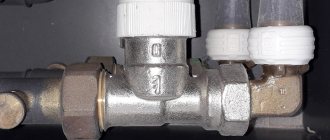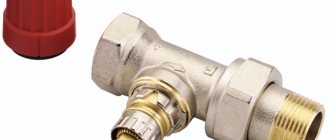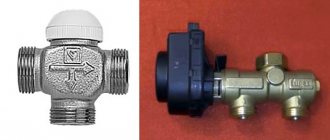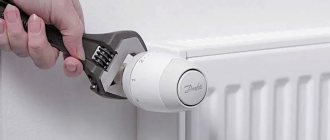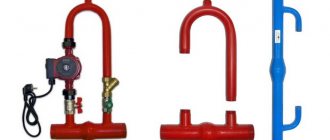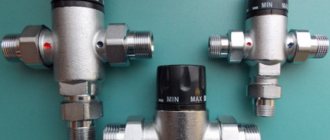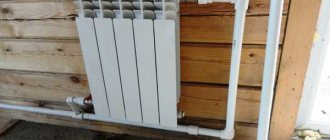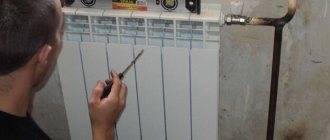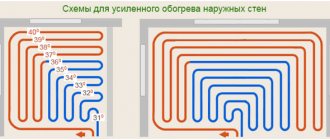Here you will learn:
- Purpose of the thermal valve
- Advantages and disadvantages
- Characteristics of thermal valves
- Valve operating principle
- Types of devices
- How to choose
- How to install correctly
- Rules for adjusting the operation of the device
- Expert advice
The thermostatic valve for a heating radiator provides regulation of the amount of coolant flowing through the radiator. Adjustment can be done either manually or automatically. This valve saves heating costs.
Purpose of the thermal valve
The valve solves two problems: maintains the room temperature at a comfortable level and saves energy.
But in order for it to really cope with such functions, you need to understand in what cases the device is appropriate and how to install it correctly.
If in the middle of winter there is a need to open the windows so that the temperature in the room drops to an acceptable level, a thermostat is definitely needed. But it won’t help when the radiators are barely warm—it will probably make it even colder.
In the second case, it is better to try to regulate the temperature in the room differently: change the volume of coolant in each radiator, adjust the operation of the boiler (for a large area), select the optimal circulation pump or adjust the operation of the existing one.
The price of a thermostat ranges from several hundred rubles (200-600), so re-equipment of the heating system will not be expensive. But there are also expensive models
As a temporary measure, control valves can be used. But it is not recommended to use ball valves for these purposes.
Installation diagram
Water heated floors today are a common system for heating a home; different schemes are used for its arrangement.
Three-way valve. We install it correctly.
Heated floor equipment with three-way valve
Installation of underfloor heating with the installation of a three-way thermostatic valve is suitable for mixed heating systems. Radiator (water temperature 80 degrees) and underfloor heating (the liquid should not heat above 50 degrees).
Thermal head for a heating radiator - operating principle, different types of devices, how to choose and install.
The question arises - how to cool the water from 80 to 50 degrees. This is what the three-way thermostatic valve is designed for. It is attached to the supply pipe, and a circulation pump is connected behind it.
The working process is as follows:
- waste cooled coolant is supplied from the return pipe;
- in the mixing chamber it is mixed with the hot liquid to a predetermined level;
- then the water flows into the branches of the floor.
The disadvantage of this method is the inability to dose the waste water mixture, and this leads to the entry of overheated or underheated coolant into the main line. Plus - easy installation and low price of equipment.
There are two installation schemes for a water heating floor with a three-way thermostatic valve; they differ in the direction of flow:
- T-shaped (symmetrical) - heated and cold coolant is supplied from the sides, water is mixed in the center of the valve body, and comes out in the middle.
- L-shaped or asymmetrical - the heated liquid enters from the side, and the cooled liquid from below. Mixed water comes out from the side, opposite the hot one.
Both valves are compact and widely used in warm hydrofloors.
Two way thermostatic return flow valve. Installation on heated floor!!!
Advantages and disadvantages
The advantages of installing thermostatic valves in the heating system include the following factors:
- Energy independence of the device.
- Compactness.
- High precision temperature control.
- Easy to operate and highly reliable.
- Aesthetic appearance.
- The optimal combination of price and functionality.
The disadvantages of using thermostatic valves are:
- Difficulty setting up.
- There is a danger of the thermal head malfunctioning under the influence of a draft or a nearby stove.
Characteristics of thermal valves
For your information, here are a number of basic technical characteristics of thermostatic valves:
- The maximum operating pressure level is 1.0 MPa.
- Pressure testing before commissioning is 1.5 MPa.
- The maximum operating temperature is +110 ºС.
- The maximum permissible ambient temperature is +50 ºС.
- The valve capacity is from 1.6 to 2.5 m³/h.
- Temperature control range - +20…+60 ºС.
- Response time: 25 min.
- MTBF with manual control - 8000 cycles.
What materials are they made from?
Corrosion-resistant metals are used to make the thermostatic valve body:
- Brass.
- Bronze.
- Stainless steel.
Additionally, the surfaces of brass products are nickel-plated, and the bronze body is either also nickel-plated or coated with a layer of chrome.
Warm floor
You should not trust sources that claim that a heated floor can be laid together with a radiator system and nothing will happen to it. For heated floors, the maximum temperature should be no more than 55C. Therefore, for such a heating circuit, it is best to install a Maybes and Buderus pump group with temperature control (for floor-standing boilers), or a Termex group from Maybes for wall-mounted boilers. These groups are installed on the circuit of heated floors. Installation location - near the boiler, where the decoupling of the heating circuits begins.
Boiler connection
Connecting a boiler (storage water heater) does not require superpowers. The main thing in this matter is to make connections according to the diagram and to properly seal all connections. Modern automatic boilers have a special connector for connecting and monitoring the operation of the boiler.
Wall-mounted boiler and boiler.
Boiler connection diagram.
Connecting the boiler to a floor-standing boiler.
Valve operating principle
The valve with thermal head is designed to maintain the set temperature in offline mode. The device operates on the principle of compression-expansion of gas or liquid depending on the environment. The thermostat can be built-in or located remotely.
The thermostatic valve has a bellows - a corrugated movable container that is filled with a heat-sensitive agent. When the surrounding air heats up, the agent increases in volume and puts pressure on the valve's shut-off cone, initiating its closure. When cooling, the reverse process occurs - the agent cools, the bellows decreases in volume and the valve opens.
There are gas and liquid bellows. Gas agents are more sensitive to environmental changes, but are more expensive and more difficult to produce. Liquid ones are less sensitive, but cheaper. The difference in temperature control accuracy is about 0.5 degrees, which is not significant.
Types of devices
Today there are several types of thermostatic valves. Among them the most popular are:
- Mechanical. They require manual adjustment of the coolant supply.
- Semi-electronic. They are controlled by a special thermal head with a bellows device.
- Electronic. Control is carried out using a remote temperature sensor.
Mechanical thermostats
The main advantages of mechanical structures are low price, smooth and precise functioning, and ease of use. During their operation, you do not need to use auxiliary energy sources. Thanks to their modification, it is possible to manually regulate the volume of coolant entering the radiator, controlling its heat transfer. In such devices you can accurately set the degree of heating.
The main disadvantage of mechanical equipment is the lack of markings for adjustment, so its adjustment is carried out mainly by trial and error. The product consists of:
- a bellows filled with a liquid or gaseous mixture;
- regulator;
- drive.
The main role is played by the substance with which the bellows is filled. When the position of the thermostat lever changes, it enters the spool, adjusting the rod. The latter, under such influence, blocks the passage, thereby limiting the entry of coolant into the radiator.
Electronic temperature sensors
Electronic devices are more complex, because they are based on a programmable microprocessor. Thanks to it, it becomes possible to set the required temperature in the room. To do this you need to press several buttons. There are multifunctional models with which you can control a mixer, boiler or pump.
The operating principle and design of electronic units are almost no different from mechanical products. Inside such equipment there is a substance that reacts to temperature changes. As the temperature increases, it expands and pressure is generated, under the influence of which the rod begins to move, automatically closing the valve. As the temperature decreases, the substance contracts, causing the valve to open.
The bellows has high strength and a long service life. The substance can withstand repeated compression throughout its entire operational period of several decades. There are the following types of electronic designs:
- Closed valves for heating batteries cannot automatically determine the temperature value, so they are adjusted manually. You can set the temperature values, as well as their permissible fluctuations.
- Open products that can be programmed. So, when the temperature decreases, the operating mode changes. In addition, it is possible to adjust the timer and configure the operation of certain modes. In most cases, such designs are in demand on an industrial scale.
Electronic products operate using batteries or a rechargeable battery sold complete with a charger. Semi-electronic valves are an ideal option for home use. They are equipped with a digital display that shows the temperature in the room.
Gas and liquid valves
When operating the regulator, gaseous or liquid substances can be used as a temperature control element. Because of this, all devices are divided into liquid and gas.
The latter have a long service life (at least 20 years). This is due to the fact that gaseous substances contribute to a clearer and smoother regulation of temperature in the room. The products are equipped with a sensor that detects temperature. The gas bellows reacts faster to temperature changes in the room.
Fluid devices more accurately transmit internal pressure to driving mechanisms. When choosing a product, most consumers focus on the service life and quality of the product. There are several types of structures:
- remote;
- having a built-in sensor.
The latter are often installed horizontally. This is due to the fact that they need air circulation around them. It is advisable to use remote units in the following situations:
- with a vertically located thermostat;
- when heating equipment is located at a distance of less than 10 and more than 22 cm from the window sill;
- the radiator is covered with thick curtains;
- battery depth is more than 16 cm;
- The radiator is located in a niche.
In such situations, the built-in thermostat will not function correctly, so most often a remote one is used. Most often, sensors are placed at right angles to the body. When installed in parallel, their values will be lost under the influence of the heat emanating from the battery.
Ball valve
This is the most famous type of shut-off valve. Inside it there is a smooth ball that has a through hole and is capable of rotating 90°C, thus regulating the flow of water in the pipe, closing or opening it. The design of the mechanism provides it with minimal resistance to flow when open. It is designed to operate in the fully open or fully closed position to quickly shut off the water or, in some cases, drain it. Intermediate provisions are possible, but prohibited.
The materials for these mechanisms will be nickel-plated brass and stainless steel; for metal-plastic systems, polymer materials are also used. There are expensive and high-quality cranes from the Danfoss, Giacomini, and Bugatti brands on the market. For limited financial capabilities, Chinese and Turkish Valtec and Fado are offered. Good quality at a low price is offered by the Chinese AGUA-WORID.
The most common type of tap is a valve. Allows you to regulate the pressure. The flow channel inside it is perpendicular to the flow of liquid in the supply pipes. Installation must be carried out with careful attention to the markings so that water flows only in one direction.
For heating systems there are valves with a conical valve. They are most effective for such conditions. Fully open, it allows the maximum amount of liquid to pass through, which makes the thermal output of the battery more efficient. The mechanism allows you to reduce the flow of coolant and reduce heat transfer if the room is too hot and, thus, control the temperature.
There are these types:
- adjusting (straight and angular). They have manual control. Used in autonomous heating. They cannot accurately adjust heat transfer due to the lack of a scale and temperature sensor;
- equipped with a thermal head. Their design allows the temperature rise to be blocked or limited through manual or automatic control. Installed on two- and one-pipe systems. Adjustment is simple - the required temperature is set manually using a limit ring;
- with thermostat. Installed in front of the battery. The flow of coolant is controlled by a tap mounted in front of the thermostat.
There are no valve taps made of plastic; they are made from brass, steel or a combination of these materials.
How to choose
The thermostat is selected according to the operating characteristics of the heating system. The device must:
- Withstand pressure in the range of 16–40 bar and temperatures up to 200 °C.
- Be made of corrosion-resistant materials that are resistant to mechanical stress.
- Match the diameter with the size of the pipeline.
- Match the thread parameters on the pipe.
Popular manufacturers
Thermostats manufactured by the following companies are considered the most reliable and durable:
- Danfoss (Denmark). Devices from this manufacturer, despite their fairly low price, have an improved design. They are equipped with a flow stabilizer, so they operate silently. They do not become clogged when working with any contaminated coolant, since their rod stroke is 1.5 times greater, and the performance adjustment window has a larger cross-section.
- Oventrop (Germany). The variety of standard sizes of thermostatic fittings from Oventrop allows you to choose the ideal model for any engineering system. Excellent regulating qualities, high product reliability are combined with an aesthetic appearance.
- Luxor (Italy). Luxor thermostats are suitable for heating systems where the coolant is hot water. They are equipped with a thermostatic spindle that allows pre-setting of the flow.
Using drives
In addition to the thermostatic head, the valve can be controlled in other ways. The first of them is manual, when the depth of pressing of the rod is determined by turning the handle outside the body. Not the best option and is only suitable if the temperature of the water entering the pipes is constant. Another option is control using a servo and electric drive, receiving commands from the controller. To work together with different drives, another type of valve is used - rotary valves, whose device is shown in the figure:
This 3 outlet valve is very similar to a regular motorized ball valve
There is a certain similarity here with a ball valve, only the working rotary element has a different hole shape to allow coolant to flow in two directions at once. The operating principle here is simple: the axis rotates to the required angle, rotated by the drive. The latter is controlled by a controller that receives impulses from one or more sensors. Typically, valve actuators are installed in complex or automated heating systems with weather control.
How to install correctly
They install a thermostat for a heating radiator at the inlet or outlet of the heating device - there is no difference, they work with equal success in both positions. How to choose a place to install?
According to the recommended installation height. There is such a clause in the technical specifications. Each device is configured at the factory - they are calibrated to control the temperature at a certain height and usually this is the upper radiator manifold. In this case, the heat regulator is installed at a height of 60-80 cm; it is convenient to adjust it manually if necessary.
Installation diagrams for heat regulators for radiators
If you have a bottom saddle connection (pipes fit only from the bottom), there are three options - look for a device that can be installed at the bottom, install a model with a remote sensor, or reconfigure the thermal head. The procedure is simple; the description must be in the passport. All you need is to have a thermometer and at certain moments turn the head in one direction, then in the other direction.
Installation is standard - on fum tape or linen winding with packaging paste
The installation process itself is standard. The valve has a thread. The appropriate fittings are selected for it or a matching thread is cut on the metal pipe.
One important point that those who want to install a thermostat for a heating radiator in apartment buildings should remember. If you have a single-pipe installation, they can only be installed if there is a bypass - a section of pipe that stands in front of the battery and connects the two pipes to each other.
If you have a similar wiring (there may not be a pipe on the right), a bypass is required. The thermostat should be installed immediately behind the radiator
Otherwise, you will regulate the entire riser, which your neighbors will definitely not like. For such a violation, a very substantial fine can be issued. Therefore, it is better to install a bypass (if not).
Types of thermostatic elements
There are mechanical, electronic and semi-electronic thermal valves for heating radiators.
- Electronic models of thermal heads have a high price. However, such devices are convenient in that they are programmed for a long period of time with adjustment by time of day and days of the week.
- Mechanical models are more affordable, but inconvenient to adjust.
- Semi-electronic models are popular among a wide range of consumers. These are devices that need to be configured manually, but then everything works autonomously. In addition, semi-electronic models of thermal valves are equipped with an electronic display for displaying information. They are a reliable and convenient device for use at home.
We recommend that you read: Novosverdlovsk Metallurgical Company
Based on the location of the heat sensor, models are distinguished:
- with built-in thermostat;
- with a separately located thermostat (remote).
Classification by purpose
Depending on the type of heating system, the valves are:
| For single-circuit heating system | The valve has a larger body cylinder and a gray regulator. The body of such a regulator is marked “G”. Used in single-circuit individual heating systems. |
| For dual-circuit heating systems. | Used to regulate the climate in rooms with central supply, where the pressure in the system is significant. Such devices are marked with the letters “N” or “D”. |
For the correct operation of a thermal valve in an apartment building, on a single-pipe heating system, a jumper must be installed in front of the valve connecting the input and output - the bypass.
If there is no such jumper, then your thermostat will work on the entire riser, which is unlikely to please the neighbors.
By material of manufacture and configuration
Valves are made from various materials:
- made of stainless steel - expensive, but the most durable models;
- bronze plated with nickel and chromium;
- nickel plated brass.
According to the configuration, thermal valves are straight, angled vertical, angled horizontal.
The devices also differ in the maximum amplitude of adjustable degrees. The more options, the more expensive the product price.
Rules for adjusting the operation of the device
After installation, you need to adjust the operation of the device. To do this, we first close the windows and doors - we insulate the room to prevent heat leakage.
Then we proceed like this:
- We turn on the heating.
- We set the valve to the position of maximum heat transfer and measure the temperature.
- We are waiting for the room temperature to rise by 5 degrees and become constant.
- Close the valve and wait for a comfortable temperature.
- Then we open the thermostat a little bit until we hear the sound of passing water. The body of the device itself should become warmer.
- The last point needs to be remembered.
In a private home, air must be bleed from the batteries before adjustment. In this case, maximum care must be taken to avoid the release of hot steam.
When more than three batteries are connected to the boiler, each thermostat must be opened to a different level so that the heat is distributed evenly throughout the rooms
The adjustment starts from the coldest room. It needs to be warmed up well before moving on to other rooms.
Expert advice
A few tips from professionals will help the apartment owner install and configure the thermostatic valve with his own hands and in accordance with all the rules:
- It is important to mount the device in such a way that the direction of water movement coincides with the direction shown by the arrow shown next to the marking on the body, otherwise the operation of the thermostatic valve will be incorrect.
- For underfloor heating systems, it is better to choose thermostats with a side valve - this makes settings easier to access.
- In public areas, thermostatic valves with remote control or pre-setting should be used for installation to protect them from outside influence.
- To seal the threaded connection, you should not use fum tape, but polymer or linen threads with heat-resistant paint. When heated and significant temperature changes occur, thermal expansion of the pipes occurs, the density of the tape may be disrupted, which will lead to the formation of a leak.
- It is more appropriate to place the valve on the supply pipe.
- The distance from the floor to the installation site of the thermostatic valve should be at least 40-60 cm. Initially, manufacturers configure them to capture temperature changes at this level. If it is necessary to change this parameter, then additional configuration of the device is performed.
- The thermostatic head must be installed on the valve in a horizontal position and turned towards the inside of the room. If you install the thermal head vertically, the warm air from the riser will interfere with the normal operation of the sensor.
- When installing a thermostatic valve in a one-pipe heating system, it is necessary to install an additional bypass section - a bypass. It should be located between the sections of pipelines entering the heating device and leaving it (as in the photo below).
Where should a 3-way valve be installed and when is it not needed?
Before selecting a three-way valve, it is advisable to make sure that it is really necessary. After all, on the Internet and in real life there are enough advisers who poorly understand the essence of the issue. So, let's list the situations when this valve is really needed:
- To protect the solid fuel boiler from the supply of cold coolant and condensation on the internal walls of the firebox.
- To regulate the water temperature in heating circuits.
- To limit the heating of the coolant in underfloor heating circuits.
A lot has been said about condensate, which provokes the formation of sticky growths on the walls of the TT boiler chamber, including. It appears during the heating process, when the temperature in the firebox is already high, and cold water comes from the heating system. To avoid this, the supply and return lines are connected by a bypass, where a 3-way valve is installed. It forces the coolant from the boiler tank to flow in a small circle, and only when heated to 50-60 °C does it begin to add water from the system.
Regulating the temperature in heating circuits using a mixing unit is necessary in the following cases:
- in complex heating systems, when several lines with different temperature conditions must be connected to a common comb, for example, a radiator network, heated floors and an indirect heating boiler;
- when connecting the same consumers to a buffer tank - a heat accumulator;
- when supplying heated water to the heat exchanger of a ventilation air handling unit used for air heating of a country cottage.
Since a coolant with a temperature of no more than 50 °C is sent to the heating circuits of heated floors, and 85 °C can be supplied from the boiler, this should be limited. Usually (but not always!) the issue is resolved by installing a mixing unit with a 3-way valve on the distribution manifold. The latter mixes chilled water from the floor circuits with the “external” coolant coming from the boiler.
Now let’s identify situations where the purchase and installation of a mixer (or separator) is not necessary:
- If the length of each loop of a water heated floor does not exceed 50-60 m, which is quite possible to achieve, then regulation is done without a mixing unit. Instead, RTL type heads are installed on the return manifold, limiting the flow by the amount of coolant.
- When 2-3 heating units alternately operate to heat a private house, maintaining a constant network temperature of at least 40 °C, then there is no need to install a three-way valve for a solid fuel boiler.
- In heating systems with natural water circulation. The reason is the pressure drop across the valve, which prevents the movement of coolant. The same applies to heat accumulators operated according to a gravity flow scheme.
If you are interested in why it is better to choose RTL heads and how they control underfloor heating circuits, watch the video from an experienced master and our expert Vladimir Sukhorukov:
